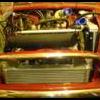Morning guys,
If you do a google search or look for ignition timing by vacuum gauge readings, there are 101 articles out there and some great videos. Those who set their timing this way generally have done for years and swear by it and it makes perfect sense by our mechanical minds and logic.
Once you have slowly advanced your timing to get the highest stable vacuum reading (Taken from inlet manifold) and then retarded by 1/2 inch of mercury pressure that is supposed to be the ideal 'true' ignition timing setting. So I have done this on many occasions, on different engines over the years and never cease to be amazed at what the resultant timing I have when I check it again using a strobe.
For example I'm just working on my 78 SA Mini GTS at the moment. According to book the timing should be 8 deg btdc at 850 rpm. However, using the vacuum method it takes it all the way up to around 20 deg btdc, which is quite a difference!
Throw in mechanical advance from the dizzy and its probably upwards of 40 deg of total advance once over 3500 rpm.
Does anyone else use the vacuum gauge method and what timing figure do you finally arrive at? Respecting to the age and wear and tear of the car etc...however how does that compare to manufacturers figures?

















